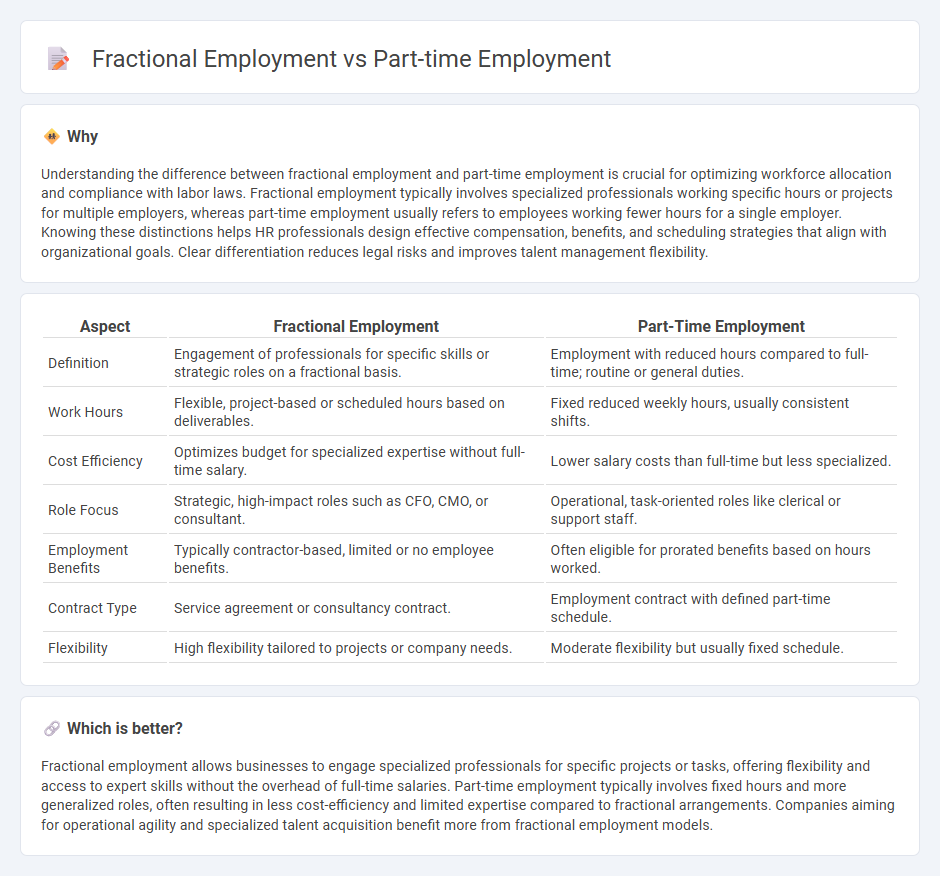
Fractional employment involves hiring professionals for specific projects or roles on a shared basis across multiple companies, optimizing expertise without full-time commitment. Part-time employment refers to workers who have a reduced number of working hours compared to full-time schedules, typically within a single employer. Explore the key differences between fractional and part-time employment to determine the best fit for your organization's hiring strategy.
Why it is important
Understanding the difference between fractional employment and part-time employment is crucial for optimizing workforce allocation and compliance with labor laws. Fractional employment typically involves specialized professionals working specific hours or projects for multiple employers, whereas part-time employment usually refers to employees working fewer hours for a single employer. Knowing these distinctions helps HR professionals design effective compensation, benefits, and scheduling strategies that align with organizational goals. Clear differentiation reduces legal risks and improves talent management flexibility.
Comparison Table
| Aspect | Fractional Employment | Part-Time Employment |
|---|---|---|
| Definition | Engagement of professionals for specific skills or strategic roles on a fractional basis. | Employment with reduced hours compared to full-time; routine or general duties. |
| Work Hours | Flexible, project-based or scheduled hours based on deliverables. | Fixed reduced weekly hours, usually consistent shifts. |
| Cost Efficiency | Optimizes budget for specialized expertise without full-time salary. | Lower salary costs than full-time but less specialized. |
| Role Focus | Strategic, high-impact roles such as CFO, CMO, or consultant. | Operational, task-oriented roles like clerical or support staff. |
| Employment Benefits | Typically contractor-based, limited or no employee benefits. | Often eligible for prorated benefits based on hours worked. |
| Contract Type | Service agreement or consultancy contract. | Employment contract with defined part-time schedule. |
| Flexibility | High flexibility tailored to projects or company needs. | Moderate flexibility but usually fixed schedule. |
Which is better?
Fractional employment allows businesses to engage specialized professionals for specific projects or tasks, offering flexibility and access to expert skills without the overhead of full-time salaries. Part-time employment typically involves fixed hours and more generalized roles, often resulting in less cost-efficiency and limited expertise compared to fractional arrangements. Companies aiming for operational agility and specialized talent acquisition benefit more from fractional employment models.
Connection
Fractional employment and part-time employment both involve working fewer hours than full-time roles, with fractional employment typically focusing on specialized tasks across multiple organizations, while part-time employment often entails regular, limited hours within a single company. Both models offer flexibility and cost efficiency for employers, catering to dynamic workforce needs and fluctuating business demands. Integration of these employment types supports talent acquisition strategies by enabling access to skilled professionals without full-time commitments.
Key Terms
Work Hours
Part-time employment typically involves working fewer than 30-35 hours per week, with a fixed schedule and set tasks, while fractional employment refers to professionals contributing specific expertise on a project or retainer basis, often with highly flexible or variable hours. Part-time roles maintain regularity and organizational integration, whereas fractional roles prioritize specialized input and scalability across multiple clients or projects. Explore further to understand which work hours structure best suits your career or business needs.
Employment Contract
Part-time employment typically involves working fewer hours than full-time, often with a fixed weekly schedule outlined in an employment contract specifying hours, duties, and benefits proportional to hours worked. Fractional employment usually refers to highly skilled professionals hired for specific projects or time blocks, with contracts focusing on deliverables, scope, and expertise rather than fixed hours. Explore the detailed distinctions in employment contracts to understand obligations, rights, and expectations better.
Benefits Entitlement
Part-time employment typically offers limited benefits entitlements proportional to hours worked, such as partial health insurance and prorated vacation days, whereas fractional employment, often structured for executive-level roles, includes comprehensive benefits aligned with the fraction of full-time equivalency worked, including retirement plans and performance bonuses. Fractional employees enjoy more tailored benefits packages that reflect their strategic contributions, compared to part-time workers who may only receive statutory minimums. Explore the differences further to understand which employment type best suits your benefits needs.
Source and External Links
Part-time job - Wikipedia - A part-time job is employment with fewer hours per week than full-time, commonly under 30 hours weekly, often with shifts that may be rotational, and part-time workers should be treated no less favorably than full-time workers by law.
Part-Time vs Full-Time: How Many Hours & How to Classify? - Part-time employment is usually defined as working from 1 up to 34 hours per week, often paid on a prorated basis compared to full-time, and benefits for part-time employees are typically more limited than full-time benefits.
Part-Time & Job Sharing - OPM - In the federal government, part-time employment typically involves working between 16 and 32 hours per week with eligibility for prorated benefits like leave, retirement, and insurance, and job sharing allows splitting one full-time position among multiple part-time workers.
 dowidth.com
dowidth.com